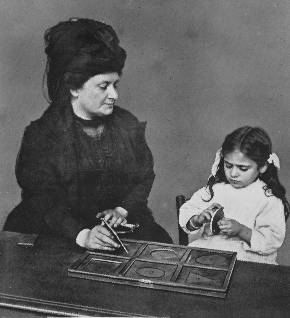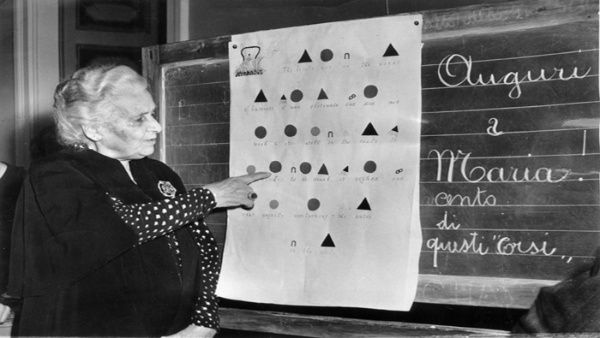About Maria Montessori method
Maria Montessori was born on August 31, 1870, in the province of Chiaravalle in Ancona, Italy. Her father, Alessandro Montessori, came from an aristocratic family in Bologna and held conservative views. Her mother, Renilde Stoppani, was a cousin of the famous philosopher Antonio Stoppani. Mother and daughter were very close.
When Maria turned 12, her family moved to Rome. Her parents wanted her to become a teacher, but Maria, on the other hand, was interested in mathematics and decided to become an engineer. In 1890, she graduated from a technical school in Rome that was primarily for young men and had a focus on natural sciences. During her studies, Maria developed an interest in biology and decided to pursue a career in medicine.

In 1892, she was admitted to the Faculty of Medicine at the University of Rome. In 1896, Maria Montessori defended her doctoral thesis on the topic of "The Investigation of Persecution Mania from a Clinical Perspective," becoming the first woman to graduate from the University of Rome as a medical doctor. Later, she also pursued further education in the field of pedagogy.
In the same year, 1896, Maria Montessori was chosen as the representative of the Italian women's movement at the feminist congress held in Berlin, where she advocated for the rights of working women.

After graduating from the university, Maria Montessori began working at a psychiatric clinic affiliated with the University of Rome. She taught children with intellectual disabilities, and her success in this role was notable. Maria Montessori discovered that intellectual disabilities were largely a pedagogical issue, and she believed that the entire education system needed to be reformed. When she participated in the 1899 congress in Turin, she advocated for making education more humane and defended the rights of disabled children, demanding that their education be on par with that of others.
From 1899 to 1901, Maria Montessori directed a school for intellectually disabled children based on scientific principles. Within this school, she prepared teachers to work with intellectually disabled children. Around the same time, she also began her studies at the Faculty of Philosophy and Psychology at the University of Rome. It was during this period that Maria started to delve into the works of various scientists regarding disabled and neurologically impaired children. She conducted thorough research and became acquainted with the works of Jean Itard and Edouard Seguin, among others.
- In 1904, Maria Montessori became a professor at the University of Rome and published her first major work, "Pedagogical Anthropology."
- In 1906, she began a series of lectures at the University of Rome for teachers, welcoming both male and female students. The interest in these lectures was tremendous, and they were considered one of the most valuable aspects of her work during her lifetime. In addition to her lectures, Maria Montessori also worked in hospitals and clinics in Rome, continuing her practice as a physician.
- On January 6, 1907, Maria Montessori opened the Casa dei Bambini, a children's house, in the San Lorenzo district of Rome.

In 1914, after the death of her mother, Maria Montessori visited the United States. Her lecture at Carnegie Hall drew an audience of 5000 people. As part of her lecture series, she wrote the book "The Method of Scientific Pedagogy as Applied to Infant Education and Children's Houses." During her visit to the United States, the Montessori Society was established, with Alexander Graham Bell among its prominent supporters. After her visit to the U.S., Maria Montessori also traveled to Argentina and other Latin American countries.
In 1919, she officially visited London for the first time, where she received a royal reception at the Savoy Hotel.

In 1948, Maria Montessori returned to India once again, where she led new courses. In 1949, she began courses in Pakistan, but she had to leave her work there and return to Europe. Her courses in Pakistan were continued by the Danish educator Albert Max Joosten.
Throughout her travels, Maria Montessori was accompanied by her only child, her son Mario Montessori. Mario also led the International Montessori Association (founded in 1929), whose goal was to disseminate Maria Montessori's scientific legacy after her passing.
In 1924, Maria Montessori met with Benito Mussolini, and following their discussions, Mussolini began to promote the Montessori method in Italian schools. However, later disagreements arose between them, and for a period, the Montessori method was removed from schools in Italy.
During the Spanish Civil War (1936-1939), Maria Montessori fled to Amsterdam.
During World War II, Maria Montessori lived in India. During her years there, she conducted several teacher training courses, which were highly popular. For example, in 1939, a course held in Madras attracted 300 teachers from all over India. After the war, she returned to England and in 1946, she opened teacher training courses in London. Maria Montessori returned to Italy in 1947, and in the same year, the Montessori Association Opera Montessori, which had been closed during the war, was reopened in Italy.
Maria Montessori passed away on May 6, 1952, in the Netherlands. Throughout her life, she was a devout Catholic. She described the nature of the child and the essence of learning as follows:
The child creates themselves through their inner forces.
The child has natural curiosity and thirst for knowledge, upon which learning should be based.
A child should not be separated from nature because they have a strong need to care for other living beings.
The child has natural curiosity and thirst for knowledge, upon which learning should be based.
In a child's development, there are sensitive periods during which learning certain skills is easiest and provides the child with great satisfaction.
The child is a whole being. Therefore, it is not practical - or even possible - to separate their development into intellectual, physical, emotional, and social aspects.
Child behavioral and other disorders are reactions through which a child communicates that their environment is inadequate and does not provide opportunities to satisfy their most important needs.
Child development theory
Maria Montessori developed a theory of child development in which human development is likened to a series of rebirths. The result of each developmental stage is a 'new individual.'
Montessori argued that every child has within them a mechanism for these stages, and that it is highly individual for each child. Specifically, in a child's development, there are sensitive periods during which learning certain skills is easiest and provides great satisfaction to the child. It is crucial that a child's needs be met at each stage of development.
According to Montessori, a child goes through four stages of development until adulthood:
The first stage of development begins at birth and lasts until the change of teeth. Montessori considered this stage as a period of personality formation when a child needs both love and protection, as well as independence and social interaction.
The end of the second period is marked by reaching puberty.
The third period (similar to the first) is, according to Montessori, a time of creative development and the emergence of individuality. During this period, individuals require special care, attention, and understanding, as significant changes are taking place within them.
She refers to the fourth period as a period of balance when the foundation laid in previous periods becomes solidified.